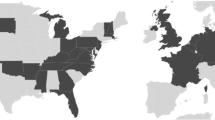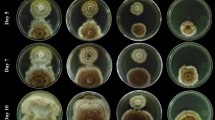Abstract
This study intended to find data on obligate ectoparasitic Laboulbeniales (Fungi, Ascomycota) on Chinese Harmonia axyridis (Coleoptera, Coccinellidae). After having screened over four thousand dried specimens of H. axyridis and close relatives, we present the first (historical) record of Chinese H. axyridis infected with Hesperomyces virescens. We suggest that H. virescens is a historically globally distributed species and hypothesize that (native) infection was lost when H. axyridis was introduced in North America.

Similar content being viewed by others
References
Blackburn TM, Cassey P, Duncan RP et al (2004) Avian extinction and mammalian introductions on oceanic islands. Science 305:1955–1958
Gaertner M, Den Bree A, Hui C et al (2009) Impacts of alien plant invasions on species richness in Mediterranean-type ecosystems: a meta-analysis. Prog Phys Geog 33:319–338
Koch RL, Venette RC, Hutchinson WD (2006) Invasions by Harmonia axyridis (Pallas) (Coleoptera: Coccinellidae) in the Western hemisphere: implications for South America. Neotrop Entomol 35:421–434
Gordon RD (1985) The Coccinellidae (Coleoptera) of America North of Mexico. J New York Entomol Soc 93:1–912
Chapin JB, Brou VA (1991) Harmonia axyridis (Pallas), the third species of the genus to be found in the United States (Coleoptera, Coccinellidae). Proc Entomol Soc Washington 93:630–635
Brown PMJ, Thomas CE, Lombaerts E et al (2011) The global spread of Harmonia axyridis (Coleoptera: Coccinellidae): distribution, dispersal and routes of invasion. Biocontrol 56:623–641
Colautti RI, Ricciardi A, Grigorovich IA et al (2004) Is invasion success explained by the enemy release hypothesis? Ecol Lett 7:721–733
Roy HE, Lawson Handley LJ, Schonrogge K et al (2011) Can the enemy release hypothesis explain the success of invasive alien predators and parasitoids? BioControl 56:451–468
Ceryngier P, Hodek I (1996) Enemies of Coccinellidae. In: Hodek I, Honěk A (eds) Ecology of Coccinellidae. Kluwer Academic Publishers, Dordrecht, pp 319–350
Roy HE, Rhule E, Harding S et al (2011) Living with the enemy: parasites and pathogens of the ladybird Harmonia axyridis. Biocontrol 56:663–679
Ceryngier P, Twardowska K (2013) Harmonia axyridis (Coleoptera: Coccinellidae) as a host of the parasitic fungus Hesperomyces virescens (Ascomycota: Laboulbeniales, Laboulbeniaceae): a case report and short review. Eur J Entomol 110:549–557
Magro A, Lecompte E, Magne F et al (2010) Phylogeny of ladybirds (Coleoptera: Coccinellidae): are the subfamilies monophyletic? Mol Phylogenet Evol 54:833–848
Benjamin RK (1971) Introduction and supplement to Thaxter’s contribution toward a monograph of the Laboulbeniaceae. Bibl Mycol 80:1–155
Santamaría S, Balazuc J, Tavares II (1991) Distribution of the European Laboulbeniales (Fungi, Ascomycotina). An annotated list of species. Treb Inst Bot Barcelona 14:1–123
Riddick EW, Cottrell TE, Kidd KA (2009) Natural enemies of the Coccinellidae: parasites, pathogens, and parasitoids. Biol Control 51:306–312
Raak-van den Berg CL, van Wielink PS, de Jong PW et al Invasive alien species under attack: natural enemies of Harmonia axyridis in the Netherlands. BioControl, accepted
Garcés S, Williams R (2004) First record of Hesperomyces virescens Thaxter (Laboulbeniales: Ascomycetes) on Harmonia axyridis (Pallas) (Coleoptera: Coccinellidae). J Kansas Entomol Soc 77:156–158
Riddick EW, Schaefer PW (2005) Occurrence, density, and distribution of parasitic fungus Hesperomyces virescens (Laboulbeniales: Laboulbeniaceae) on multicolored Asian lady beetle (Coleoptera: Coccinellidae). Ann Entomol Soc Am 98:615–624
Riddick EW (2006) Influence of host gender on infection rate, density and distribution of the parasitic fungus, Hesperomyces virescens, on the multicolored Asian lady beetle, Harmonia axyridis. J Insect Sci 6:1–15
Nalepa CA, Weir A (2007) Infection of Harmonia axyridis (Coleoptera: Coccinellidae) by Hesperomyces virescens (Ascomycetes: Laboulbeniales): role of mating status and aggregation behavior. J Invertebr Pathol 94:196–203
Harwood JD, Ricci C, Romani R et al (2006) Prevalence and association of the Laboulbenialean fungus Hesperomyces virescens (Laboulbeniales: Laboulbeniaceae) on coccinellid hosts (Coleoptera: Coccinellidae) in Kentucky. USA Eur J Entom 103:799–804
Harwood JD, Ricci C, Romani R et al (2006) Historic prevalence of a laboulbenialean fungus infected introduced coccinellids in the United States. Antenna 30:74–79
De Kesel A (2011) Hesperomyces (Laboulbeniales) and coccinellid hosts. Sterbeeckia 30:32–37
Riddick EW, Cottrell TE (2010) Is the prevalence and intensity of the ectoparasitic fungus Hesperomyces virescens related to the abundance of entomophagous coccinellids? Bull Insectol 63:71–78
Riddick EW (2010) Ectoparasitic mite and fungus on an invasive lady beetle: parasite coexistence and influence on host survival. Bull Insectol 63:13–20
Haelewaters D, De Kesel A. Laboulbeniales van De Kaaistoep D (2011) Natuurstudie in De Kaaistoep. In: Cramer T, van Wielink P (ed) 16e onderzoeksjaar. NV Tilburgsche Waterleiding-Maatschappij, KNNV-afdeling Tilburg & Natuurmuseum Brabant, Verslag 2010, Amsterdam, pp 107–112
Herz A, Kleespiel RG (2012) Occurrence of natural enemies in different populations of the invasive ladybird Harmonia axyridis (Pallas, 1771) Coleoptera, Coccinellidae) in Germany. Mitt Dtsch Ges Allg Angew Entomol 18:201–206
Steenberg T, Harding S (2010) Entomopathogenic fungi found in field populations of the harlequin ladybird, Harmonia axyridis. IOBC/wprs Bull 58:137–141
Haelewaters D, van Wielink P, van Zuijlen JW et al (2012) New records of Laboulbeniales (Fungi, Ascomycota) for the Netherlands. Entomol Ber 72:175–183
Cottrell TE, Riddick EW (2012) Limited transmission of the ectoparasitic fungus Hesperomyces virescens between lady beetles. Psyche 72:1–100
Haelewaters D, Nuytinck J, De Kesel A (2012) Laboulbeniales (Fungi, Ascomycota) in the Netherlands: an introduction. Natuurh Maandblad 101:88–93
Ceryngier P, Roy HE, Poland RL (2012) Natural enemies of ladybird beetles. In: Hodek I, van Emden HF (eds) Ecology and behavior of the ladybird beetles (Coccinellidae). Blackwell Publishing Ltd, Hoboken, pp 375–443
Thaxter R (1891) Supplementary note on North American Laboulbeniaceae. Proc Amer Acad Arts Sci 25:261–270
Finlayson CJ, Alyokhin AV, Porter EW (2009) Interactions of native and non-native lady beetle species (Coleoptera: Coccinellidae) with aphid-tending ants in laboratory arenas. Environ Entomol 38:846–855
Spegazzini C (1917) Revisión de las Laboulbeniales Argentinas. An Mus Nac Hist Nat Buenos Aires 29:445–688
Thaxter R (1931) Contribution towards a monograph of the Laboulbeniaceae. Mem Amer Acad Arts Sci 16:1–435
Lombaert E, Guillemaud T, Cormuet JM et al (2010) Bridgehead effect in the worldwide invasion of the biocontrol harlequin ladybird. PLoS ONE 5:e9743
Acknowledgments
We wish to thank Piotr Ceryngier and Lidwien Raak-van den Berg for useful comments on the manuscript.
Author information
Authors and Affiliations
Corresponding author
About this article
Cite this article
Danny, H., Comont, R.F., Zhao, S.Y. et al. Hesperomyces virescens (Fungi, Ascomycota, Laboulbeniales) attacking Harmonia axyridis (Coleoptera, Coccinellidae) in its native range. Chin. Sci. Bull. 59, 528–532 (2014). https://doi.org/10.1007/s11434-013-0060-1
Received:
Accepted:
Published:
Issue Date:
DOI: https://doi.org/10.1007/s11434-013-0060-1




